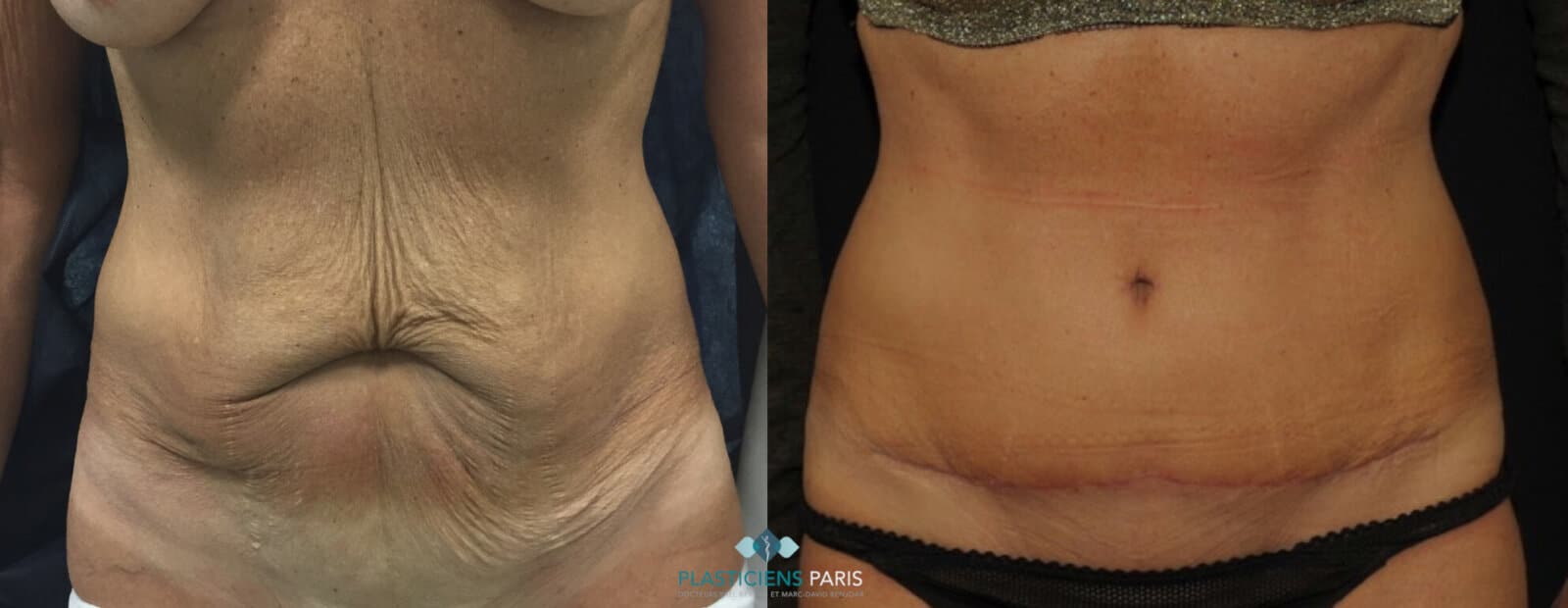Abdominoplastie ou plastie abdominale à Paris : Prix et prise en charge
Tummy tuck or abdominoplasty is a cosmetic surgery procedure designed to restore a flat, harmonious stomach following, for example, a change in weight or pregnancy.
Principles of abdominoplasty
Surgery consists in tightening the abdomen by removing fat and damaged skin (distended or stretch marks) below the navel.
There are 2 types of tummy tucks:
- a tummy tuck without transposition of the umbilicus or mini-abdominoplasty
- abdominoplasty with transposition of the umbilicus, possibly associated with re-tensioning of the abdominal muscles (diastasis cure)
To perfect the result, we almost always combine abdominal liposuction with our tummy tucks.

Abdominoplastie (Plastie abdominale) en pratique
An abdominal CT scan may be requested prior to the procedure to assess the presence of any hernia.
Before the operation, it is necessary to order an abdominal support girdle to be worn day and night for a month following the operation.
The procedure is most often performed under general anesthesia, but can also be performed under epidural anesthesia. This requires a pre-anesthetic consultation at least 48 hours before the operation.
A mini-abdominal surgery can be considered in ambulatory surgery.
In other cases, a conventional hospitalization of 2 to 4 days is necessary.
Find out more about before-and-after abdominoplasty results .

Questions / Réponses sur l’abdominoplastie ou Plastie abdominale à Paris
Est-ce que une abdominoplastie est douloureuse ?
It all depends on whether the abdominoplasty is combined with a tightening of the abdominal muscles.
If this is not the case, the pain is equivalent to that of liposuction, and can therefore be tolerated with level 1 analgesics.
If the abdominal muscles are brought closer together (diastasis cure), the pain is greater and may require a prescription of morphine derivatives for around 10 days.
What are the possible complications of a tummy tuck?
Abdominoplasty with transposition of the umbilicus is a major operation requiring careful attention.
The most feared complication is the occurrence of thrombo-embolic events (phlebitis and pulmonary embolism). Preventive measures include getting up early, wearing compression stockings and taking subcutaneous heparin injections for 10 to 14 days after the operation.
A hematoma (blood clot) may occur in the days following surgery, requiring a return to the operating room.
Lymph effusion or seroma occurs in around 10% of cases. If it is significant, it may require a puncture (a painless procedure). Healing problems may occur, particularly in smokers or diabetics.
Lastly, sensitivity problems in the abdominal skin below the umbilicus are almost systematic after the operation. These are corrected within a year of the operation.
Mini-abdominoplasty is a faster procedure, so complications are rarer.
What is the post-operative care after a tummy tuck?
Les soins doivent être rigoureux après une abdominoplastie.
Un(e) infirmièr(e) renouvellera le pansement tous les 1 à 2 jours. Dans le même temps, Il/elle réalisera une injection d’héparine sous cutanée.
Deux prises de sang seront nécessaires dans les 10 jours qui suivent l’opération afin de contrôler votre taux d’hémoglobine et de plaquettes.
Can a tummy tuck be covered by social security?
Yes, but in very specific cases. The following criteria must be met:
- that your abdomen falls on your pubic bone when you are standing (mandatory criterion)
- you have recently lost weight
Having had 3 children or a Caesarean section does not mean that abdominoplasty is covered by social security.
Prix d’une abdominoplastie : Combien coûte une plastie abdominale ?
For cosmetic surgery, prices range from €6,000 to €9,000 for a mini-abdominoplasty or full abdominoplasty.
If the procedure is covered by the French social security system, we charge additional fees of between €3,000 and €4,500, which may be covered by your supplementary health insurance.
Have a question? Please contact us!
Cosmetic surgery in Paris
Docteur Yaël Berdah and Docteur Marc-David Benjoar
Plastic surgeons in Paris France
